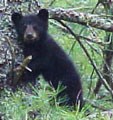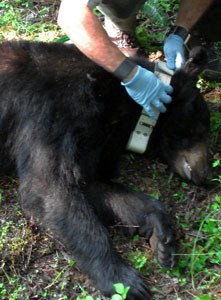|
Research Partner Profile from 2009 “It’s going to be a good year for bears,” said research ecologist Dr. Frank van Manen. He would know. Van Manen, with the University of Tennessee, has been part of the longest-running black bear research program in North America, and has followed bear population trends in the Smokies closely. Visitors may see more bears than usual—and park wildlife managers may be more busy than usual, he explains—because last year’s mast (fruit, seed, and nut) crop was especially good. Researchers and managers measure hard mast such as acorns, and soft mast such as berries and grapes. While oaks didn’t produce a very good crop of acorns last fall, the amount of hickory nuts and especially wild grapes “was pretty incredible.” Late into the fall and early winter, the bear researchers were still finding traces of wild grape in bear scat. 
NPS photo. All of this plentiful food means that more cubs survive to adulthood, and more healthy adult bears successfully reproduce. “We had a high [population] level to begin with,” said van Manen. “We’re looking at quite a few yearlings that will be kicked out” by their mothers and have to establish their own home ranges, “which could mean trouble for Bill and Kim in coming years.” Bill Stiver and Kim Delozier, wildlife managers, are responsible for making sure all those young, exploring bears don’t wander into your campsites or picnic areas. We weren’t always able to make these connections between food supplies and bear populations, let alone predict which years might bring more reports of nuisance bears. When the University of Tennessee study first began in the late 1960s, van Manen’s predecessor and mentor Dr. Mike Pelton was just figuring out what research questions to ask. The National Park Service, in their attempts to better understand and manage bears in the Smokies, asked Pelton if he could set up a bear study. No one knew how many bears lived within the Park boundaries, or anything about the wild bears that stayed away from humans. Additionally, hunters around the region—in Georgia, Tennessee, and North Carolina—were finding fewer bears, a sign of a possible problem for the population overall. 
NPS photo. Setting Up a Bear Baseline In the late 1960s, park managers thought that as few as 50 black bears might roam within the Park. At that time, no one guessed that dozens of bears lived a quiet life in the wild for every one that caused trouble with visitors. To eventually come to this conclusion, Dr. Pelton and his students—including van Manen, who was a graduate student in the early 1990s and then full time research ecologist, had to start with a baseline study. The first step of the baseline was estimating the population. Counting bears was never easy—bears are secretive and active when people aren’t—but researchers adapted their methods over the years. Live trapping of bears took place for 8 weeks each summer and has provided the basis for the long-term study through 2006. When researchers trap bears, they use different methods to track them. These methods changed considerably over time:

NPS photo. Both of these methods provided researchers with an estimate of the total number of bears in the national park, which was around 600 bears in the early 1970s. They witnessed substantial population growth during the early to late 1990s, and now that number is closer to 1600 bears. These methods didn’t give them any information about overall bear home ranges, habitat use, diet, and reproduction, however. To find these answers, which would help wildlife managers make long-term decisions, they continued the baseline study with this technique:
In addition, researchers developed techniques based on information from the long-term study that managers can use to monitor the bear population and their food resources:
The bait station, mast surveys, and DNA collection are good ways to study populations, van Manen explained, because they provide detailed information at different scales—from the entire population to individuals—but they don’t require capturing animals to understand Park-wide trends. The DNA collection and analysis provides the best information but a large obstacle to this form of research is cost. As a result, the Park has not yet switched to this type of population monitoring. For those of you still in school, a few suggestions for pursuing a career in wildlife management. Return to Black Bear page. |
Last updated: June 1, 2016
